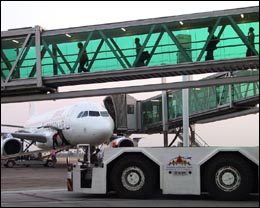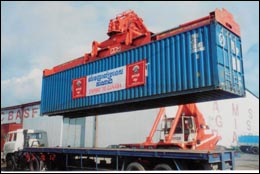 Infrastructure Infrastructure
|
Development of the transport and communications
systems and improved delivery of water and power
supplies is essential to the achievement of economic
growth with equity and social development. In
fact, Cambodia's infrastructure, which was almost
completely destroyed after more than twenty years
of warfare, civil strife and neglect, is slowly
being restored.
The current transport system consists of the
road network, railways, inland waterways and ports,
and air transport. For domestic traffic, the road
network is dominant: almost 65% of passenger kilometers
per year and 69% of the freight are carried by
road. Boats carry about 15 and 20% of the passengers
and cargo, respectively; and rail carries the
remaining 20% of passengers and 10% of cargo.
International seaports at Sihanoukville and Phnom
Penh are the key gateways linking the country
to regional and international markets, handling
an estimated 1.6 million tons of cargo in 2003.
International airports in Phom Penh and Siem Reap
are also important gateways for growing passengers
traffic.
 Road transport Road transport |

The Cambodian government has not allocated significant
budget resources to repairing the country's roads
but the highways system is therefore being rehabilitated
through bilateral foreign assistance projects
and multilateral loans, as they become available.
For example, completion of the US Aid-funded Route
4 rehabilitation project in late 1996 improved
links between Phnom Penh and the deepwater port
of Sihanoukville. Japan has rebuilt portions of
routes 6 and 7 between the capital and Kampong
Cham and it is constructing a USD 57 million bridge
over the Mekong River at Kampong Cham. The World
Bank and ADB also plan to support rehabilitation
of routes 3, 5, 6 and 7 with loans.
At
the Ministry of Public Works & Transports
(www.mpwt.gov.kh), H.E. Minister Khy Taing
Lim, explains: "The first priority will be
given to the 2.800 km of the National road system
that connects the capital to the provinces".
The second priority will be given to an additional
1900 km of the National road system that more
directly links adjacent provinces and connects
small communities with towns and cities. This
road rehabilitation will strengthen the linkage
between the three broad economic zones which are:
tourism zone formed by Siem Reap, Preah Vihear
and Kompong Thom, the industrial zone defined
by the coastal region and the agricultural zone,
covering the eastern region of the Mekong river.
Ongoing projects will cost a total of USD 236.6
million, of which donors will finance 71% and
the government 19%, leaving 10% not funded at
the start of second Road Rehabilitation Program.
 Railway
transport Railway
transport |
The railway system consists of a 386 km Northern
line constructed between 1929 and 1942, which
runs from Phnom Penh to Poipet in the north west;
and a 246 km Southern line built in the late 1960s
which runs from the capital to the deep sea port
at Sihanoukville. The line near Thai border was
so damaged as to make it unusable at any speed
and the Southern track remained in reasonable
condition but the formation was poor and 70% of
sleepers needed replacing. Rail traffic nonetheless
showed signs of increasing as peace and security
were established. In 1997, it was estimated that
a total investment of USD 7-10 million would be
needed to allow safe operations and increased
capacities of 7-8 trains per day on the Southern
line. The Northern line runs through rich agricultural
areas that are poorly served by the road network,
and potentially connects with the Thai railway
system, becoming part of the proposed Trans Asian
Railway linking the ASEAN sub-region with China.
In this aspect there is still much to do as H.E.
Minister Khy Taing Lim, underline: "just
to give you an idea, I will share with you a significant
figure; before the war the average speed on our
railways system was about 60km/hour, nowadays
we are hardly reaching 20km/hour and with a significant
highest rate of accidents (...) But the royal
government can not face this challenge by its
own and hopes to find foreign investors that would
be interested in a Joint Venture, which will allow
the railways to remain public but would grant
them the rehabilitation and commercial management."
|
 Cambodian
airports and the "Open sky policy" Cambodian
airports and the "Open sky policy" |

In the airway sector we can underline the strong
participation of foreign investors. At present,
seven domestic airports are operated in Rattankiri,
Mondulkiri, Stung Treng, Battambang, Koh Kong,
Previhear and Kratie. H.E Sok An, Minister of
the council of Ministers insist that: "BOT/BOO/BOOT
arrangements are being sought for upgrading five
of these; Koh Kong, Stung Treng, Rattankiri, Previhear
and Mondulkiri."
Pochetong International Airport in Phom Penh
is contracted out for operation, management and
development on a built-operate-transfer basis
to a French-Malaysian consortium, SCA
(Société Concessionnaire de l'Aéroport)
, and for the operational side of the airport
to CAMS
. In April 2000, the government entered into an
agreement that provides for a concessionaire to
operate Siem Reap Airport and share revenues with
the government. Mr. Denis Leluc, General Manager
of CAMS said: "(…) in April 2000, CAMS
was operating only one airport and with a staff
of 150. Three months later, in June, we had 2
airports, cargo terminals, ground activities and
600 staff. (…) Our main objective has been
always to improve the quality of our operations
and to bring both airports to international standards".
In the long term it is expected that a new international
airport will be constructed in Siem Reap to meet
the demand of growing air traffic and for development
into a profitable and self-financing operation.
Having a grid of airports, the next challenge
was indeed to increase the traffic and by the
open sky policy the government has seen an opportunity
not only to boost the airports activity but also
its tourism sector as H.E
Veng Sereyvouth, Minister of Tourism underlines:
"When you are relying on the regional market
and the local market you have no other policy
than to allow them to fly direct to our country.
Open up the country, open up the sky".
Concerning the possible creation of a new national
carrier -the Royal Air Cambodge -bankrupted in
2000- the Minister in charge of The
Council of Ministers H.E.
Sok An, informed that "Our royal government
is doing its best to find out a partner for re-establishing
our new national airlines", but so far no
agreement have been achieved.
 Shipping
and fluvial transport Shipping
and fluvial transport |
There is one fluvial port in Phom Penh, which
was rehabilitated with Japanese assistance. The
internal waterways have a high potential with
their 1700 km, but only 100km are currently used.
Plans are on their way to reactivate the life
of this port, which is located in the center of
Cambodia, in the crossroads of the main rivers
of the country (Mekong, Tonle Sap and Bassac)
and close to the manufacturing centers as well
as to the consumers themselves. To realize this
change, the Port's Director General, Mr. Hei Bavy
is applying a new strategy: "Although the
Port of Phnom Penh was designed for general cargo,
in 2002 we started considering a change in our
strategy to swift our activities towards the main
purpose of serving the container traffic"

The second and most important port of Cambodia,
is the deep sea Autonomous Port of Sihanoukville
(www.pas.gov.kh). It is managed by a state-owned
enterprise; it is involved in its third phase
of reconstruction. This phase started in 2002
and will be finished by April 2004, once finished
the port will have a fully operational container
terminal. The Minister of Public Works and Transport
forecasts an increase of the harbor's activity
with an improvement of high technological facilities
linked with a sound management which will allow
a decrease of running costs, as the Kingdom is
located at the heart of the ASEAN market. The
improvements are already starting to be seen in
the statistics of the port's activity, as the
Sihanoukville's Autonomous
Port General Director, Mr.
Lu Kim Chhun explains: "the current statistics
are very encouraging; in the first three months
of this year 2003 the volume increased 28 percent
compared with same time in 2002".
Rebuilding infrastructures in indeed one of the
main challenges of the Royal Government of Cambodia.
Nevertheless foreign assistant in this matter
is crucial and haven't achieved the level expected
in order to open up the country and therefore
speed up its development. In terms of development
of the tourism sector for instance the road from
Siem Reap to Phonm Penh, is still a pity and discourage
many to even think about traveling by road in
between this two destination. On the same way
the road linking Phnom Penh to Hanoi lack of liability
and comfort and discourage the entry of nearly
10 million tourists visiting the neighboring countries.
A special emphasis has nevertheless been put in
the road network and significant improvements
are to be seen in the coming years.
|

